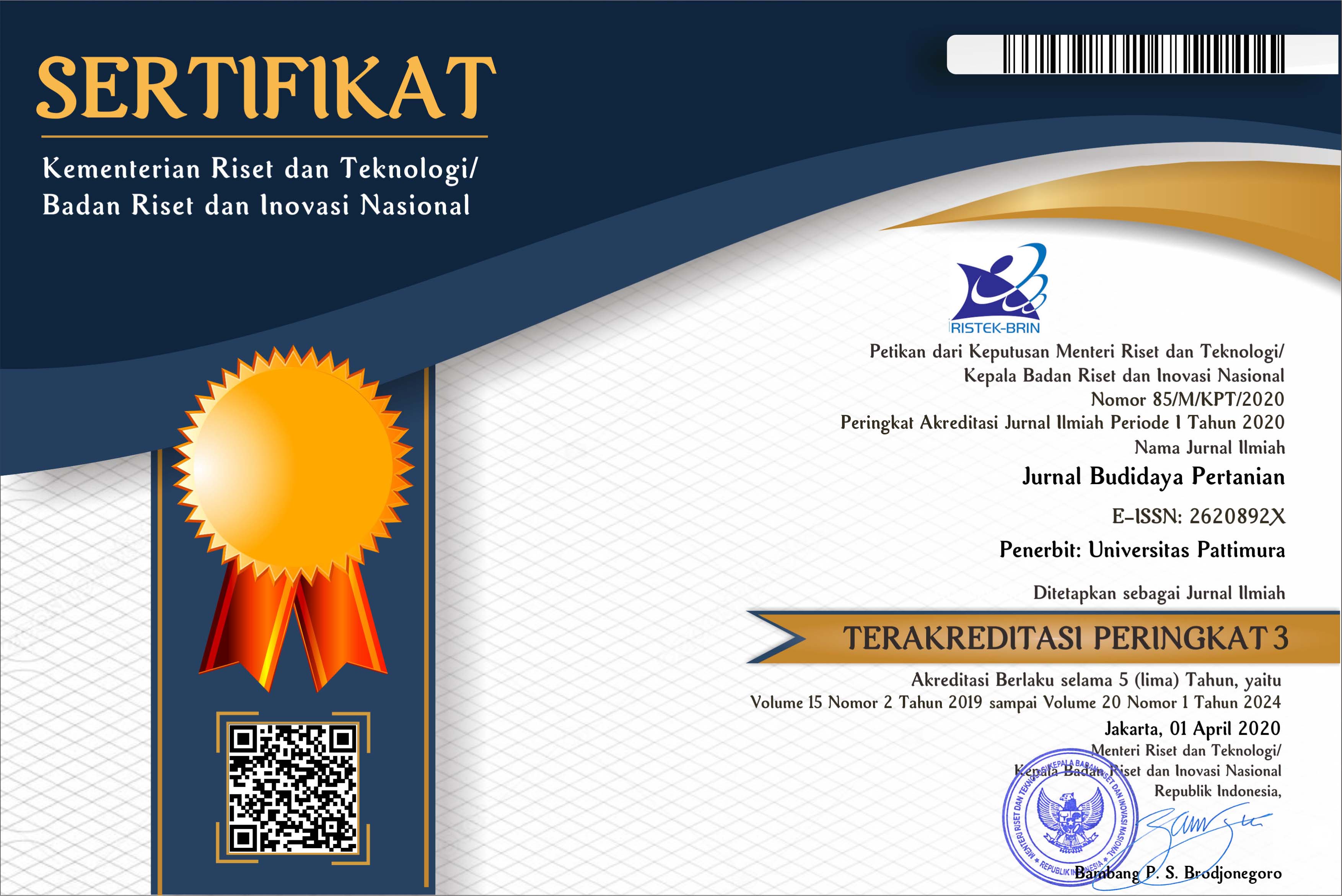Morphological Identification of Five Endophytic Fungus Isolates from Shallots and Their Ability to Inhibit Alternaria porri Ellis Cif
Abstract
One of the obstacles in shallot cultivation is the attack of purple spot disease caused by the fungus Alternaria porri. Alternative disease control that can be done and is relatively safe for the environment is biological control using indigenous endophytic fungi isolated from the plant to control the disease. Biological control using indigenous microorganisms will be more successful because of their higher compatibility and adaptability. This study aimed to characterize and determine the ability of 5 isolates of endophytic fungi islated fron shallot to control the pathogenic fungus Alternaria porri in vitro. It was carried out through observation and experiment, consisting of: (1) isolation and characterization of endophytic fungi on shallots and (2) in vitro testing of endophytic fungi against A. porri. The data obtained from observations were analyzed descriptively and the data from the inhibitory test were analyzed by analysis of variance, to test five endophytic isolates obtained from shallot root and leaf tissues. The results of this study indicated that: (1) isolate B belonged to the genus Nigrospora, isolate C to the genus Aspergillus, isolate D to the the genus Epicoccum, whereas isolates A and E were unknown; (2) 5 isolates of this indigenous endophytic fungus were hypovirulent with a disease severity index <2 so that they could be used as disease control agents; (3) 5 isolates of indigenous endophytic fungi of shallots showed inhibition ranging from 47.76%-55.25%, with isolate C genus Aspergillus having the highest inhibition with a percentage of 55.25%.
Downloads
References
Abdel, S.H., K. Aboelyours dan I. Abdelrahim. 2015. Leaf surface and endophytic fungi associated with onion leaves and their antagonistic activity against Alternaria porri. Czech Mycology 67: 1-22. https://doi.org/10.33585/cmy.67101.
Ansar, M dan M.R. Dabbas. 2012. Influence of abiotic environmental factors on purple blotch disease (Alternaria porri Eliss CIF.) of onion. International Journal of Agricultural Science 8: 171-173.
Barnett, H. L. and B. B. Hunter. 1998. Illustrated genera of imperfect fungi. Burgess Publishing Company. Minneapolis, Minnesota. 218 p.
Ginting, R.C.B., N. Sukarno, U. Widyastuti, L.K. Darusman, dan S. Kanaya. 2013. Diversity of Endophytic Fungi from Red Ginger (Zingiber officinale Rosc.) Plant and Their Inhibitory Effect to Fusarium oxysporum Plant Pathogenic Fungi. Hayati Journal of Biosciences 20: 127-137. https://doi.org/10.4308/hjb.20.3.127.
Gunaeni, N. 2015. Pengendalian hama dan penyakit secara fisik dan mekanik pada produksi bawang daun (Allium fistolosum L.). Jurnal Agrin 19: 37-51.
Hutabalian, M., M.I. Pinem, dan S. Oemry. 2015. Uji antagonisme beberapa jamur saprofit dan endofit dari tanaman pisang terhadap Fusarium oxysporum f.sp. cubens di laboraturium. Jurnal Online Agroteknologi 3: 687-695.
Kementrian Pertanian. 2019. Data Lima Tahun Terakhir Produktivitas Bawang Merah menurut Provinsi 2015-2019. https://www.pertanian.go.id/home/?show=page&act=view&id=61. Diakses pada tanggal 20 Oktober 2021.
Lelana, N.E., I. Anggraeni, dan N. Mindawati. 2015. Uji antagonis Aspergillus sp. dan Trichoderma spp. terhadap Fusarium sp. penyebab penyakit rebah kecambah pada sengon. Jurnal Penelitian Hutan Tanaman 12: 23-28.
Ogerek, R. dan E. Plaskowska. 2011. Epicoccum nigrum for biocontrol agents in vitro of plant fungi pathogens. Commun Agric Appl Biol Sci 76: 691-697.
Rathod, D.P., M.A. Dar, A.K. Gade, dan M.K. Rai. 2014. Griseofulvin producing endophytic Nigrospora oryzae from Indian Emblica officinalis gaertn: a new report. Austin Journal of Biotechnology and Bioengineering 1: 1-5.
Rodriguez, R.J., J.F.J. White, A. E. Arnold, dan R.S. Sedman. 2009. Fungal endophytes: diversity and functional roles. New Phytologist 182: 314-330. https://doi.org/10.1111/j.1469-8137.2009.02773.x.
Sari, W dan S.A. Inayah. 2020. Inventarisasi penyakit pada dua varietas local bawang merah (Allium ascalonicum l.) Bima Brebes dan Trisula. Jurnal Pro-Stek 2: 64-71.
Semangun, H. 2007. Penyakit-penyakit Tanaman Hortikultura di Indonesia. Gadja Mada University Press. Yogyakarta.
Sinaga, M.S. 2006. Dasar-dasar Ilmu Penyakit Tumbuhan. Penebar Swadaya. Jakarta.151 p.
Soesanto, L. 2008. Pengantar pengendalian hayati penyakit tanaman. PT. Raja Grafindo. Jakarta. 574 p.
Sneh B., E. Yamoah dan A. Stewart. 2004. Hypovirulent Rhizoctonia spp. isolates from New Zeland soils protected radish seedlings against damping-off caused by Rhizoctonia solani. New Zealand Plant Protection 57: 1-5 https://doi.org/10.30843/nzpp.2004.57.688.
Watanabe, T. 2002. Pictorial of soil and seed fungi. CRC-Press. Boca Raton. 504 p.
Worosuryani, C., A. Priyatmojo, dan A. Wibowo. 2006. Uji kemampuan jamur tanah yang diidolasi dari lahan pasir sebagai PGPF (Plant Growth Promoting Fungi). Agrosains 19: 179-191.
Woudenberg, J.H.G., M. Truter, J.Z. Groenewald dan P.W. Crous. 2014. Large-spored Alternaria pathogens in section Porri disentangled. Studies in Mycology 79: 1-47. https://doi.org/10.1016/j.simyco.2014.07.003.
Copyright (c) 2022 Yetti Elfina, Muhammad Ali, Siti Fatimah Wulandari, Roy Ibrahim

This work is licensed under a Creative Commons Attribution-ShareAlike 4.0 International License.

 Accreditation is valid for 5 years, starting from Volume 15 Issues 2 December 2019 up to Volume 20 Issue 1 June 2024.
Accreditation is valid for 5 years, starting from Volume 15 Issues 2 December 2019 up to Volume 20 Issue 1 June 2024.






